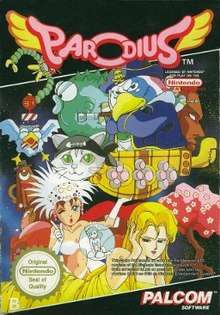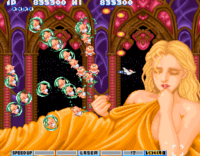Parodius! From Myth to Laughter
Parodius! From Myth to Laughter (パロディウスだ! -神話からお笑いへ-, Parodiusu Da! Shinwa kara Owarai e, lit. "It's Parodius! From Myth to Laughter"), released outside Japan as Parodius (from "Parody Gradius"), is a shoot'em up arcade game and is the second title in the Parodius series produced by Konami. The European SNES version is also known as Parodius: Non-Sense Fantasy. The gameplay is stylistically very similar to the Gradius series, but the graphics and music are intentionally absurd.
| Parodius! From Myth to Laughter | |
|---|---|
 European NES box art | |
| Developer(s) | Konami |
| Publisher(s) | Konami |
| Series | Parodius |
| Platform(s) | Arcade
|
| Release | April 25, 1990
|
| Genre(s) | Horizontal scrolling shooter |
| Mode(s) | Single-player, multiplayer |
| Cabinet | Upright |
| Display | Raster, 288 x 244, horizontal orientation |
This game is often mistaken as the original game of the series. The lesser known original game, Parodius: The Octopus Saves the Earth, was released for the MSX computer in Japan.
Story
The Great Octopus has threatened Earth. To help Parodius save the planet, you and his friends must begin your search for the truth. As you search the whole world over you must find the enemy and you must destroy him.
Gameplay

As stated above, gameplay is very similar to the Gradius series with a few differences. Parodius retains the selectability of different weapons configurations but implements via four different characters: Vic Viper (from Gradius), Octopus, TwinBee, and Pentarou. The second main difference is the addition of bell power-ups, from the TwinBee series. These bells act as one-time power-ups, allowing the player to destroy every enemy on screen, fire huge beams of energy, etc. Enemies and environments from the Gradius games and TwinBee are mixed in along with a host of anime-style opponents, including scantily-clad women. All of the Gradius elements are integrated in a light-hearted fashion. The Big Core, a regular boss within the Gradius series, is given a neon look and is called "Viva Core". Moreover, there is a moai (Easter Island head statues) level, but all of the statues are given a much more animated look. The boss of that level, Yoshiko, fires other moai at the player by spitting them out of her mouth. The final boss, in typical Gradius fashion, is an unarmed enemy that once defeated results in a destruction/escape sequence.
Characters and weapons
Vic Viper – Traditional Gradius configuration
The missile will fall to the ground, and then move along until it encounters an enemy. The Double mode will fire two blasts, one forward, and one incline forty-five degrees above. The Laser mode is a thin blue laser, identical from Gradius.
Octopus – Salamander configuration
This configuration is identical to the weapons presented in the Salamander arcade game. The missile is '2-way' that yields two bomb-like explosives that fall both up and down. The Double is the tail gun present in the second configuration. And the laser is the ripple laser, which fires expanding concentric circles at the front of the craft/person.
TwinBee (Colored as Winbee) – TwinBee configuration
This set is the weapons from the vertically scrolling TwinBee, applied to horizontal gameplay. The missile is now the rocket punch, which has a larger impact area than the standard missile. The double is the same tail gun from the Octopus/Salamander configuration. The laser is a 3-way gun which fires shots the same size as the Double and standard weapons.
- Due to the color bug, it could be considered that Winbee, rather than TwinBee, has the most appearances in video games, however this TwinBee doesn't have the same cockpit windshield design as either TwinBee, Winbee or Gwinbee.
Pentarou – Gradius II: Gofer's Ambition configuration
This set is almost identical to one of the power meter sets in Gradius II: Gofer's Ambition. The missile is the photon torpedo (spelled here "Poton") that fires one missile that travels along the bottom ground and penetrates multiple enemies. The Double mode will fire two blasts, one forward, and one incline forty-five degrees above. The laser mode is different from Gradius II; instead of a ripple laser analog it fires bullets that create small explosions upon impact.
Bosses
Below is listing the bosses from the original version:
- Cat Battleship
- Captain Penguinovski the 3rd
- Chichibinta Rika
- Eagle Eagle Sabnosuke
- Hot Lips
- Pig Tide
- Yoshiko
- Viva Core
- Honey Mikayo
- Pooyan
- Iron Maiden MK III
- Yoshiwara Dayuu
- Showering Beauty
- Golgotha Takobee
The platform-exclusive bosses include Penguin Conducter, Madam of Yotsuya Q, Viking Moai, Woon Botton, Crystal Golem, Marvelous Green Mantle, Great Gourmet King Manjiri Kun, Super DX Emperor Penguin, Tako Hyuuma, Penguin Bomb.
The NES version replaces Chichibinta Rika with Miss Mishitarina and Honey Mikayo does not appear within the game at all despite them appearing on the European NES cover.
Hot Lips, Pig Tide, Honey Mikayo, Iron Maiden MK III and Yoshiwara Dayuu not appears in this Mobile version.
Other Appearances
- Captain Penguinovsky the 3rd, Hot Lips and Chichibinta Rika from Parodius Da! appears in the puzzle game Pixel Puzzle Collection to commemorate the 30th anniversary of the Parodius series.
Music
| Parodius da! -Shinwa kara Owarai he- | |
|---|---|
| Soundtrack album by | |
| Released | July 20, 1990 |
| Recorded | 1990 |
| Genre | Video game soundtrack |
| Length | 47:07 |
| Label | King Records |
- The soundtrack was produced by Konami Kukeiha Club and released by King Records on July 21, 1990 in Japan. It was also reprinted on September 23, 1998.
- A CD Arrangement was released on June 21, 1991.
- A Ending Music for Parodius for Game Boy Version was a part of Konami Ending Collection, Which was released for CD Soundtrack on October 21, 1991.
- In addition, disc 4 of Konami Music Masterpiece Collection, which was released on October 1, 2004, is devoted to this game.
- The Songs of Parodius Da! were: Northern Country '90 and Night of the Living Dead was contain CD Music what it is part of LEGEND COMPILATION SERIES - Classic in Game Music on September 21, 2005 in Japan.
Adaptation
- Parodius Da! is one of the video games featured in the manga titled Rock'n Game Boy, by Shigeto Ikehara and Published by Comic BomBom October 1989 to December 1991.
- In the Fushigi Shoujo Nile na Thutmose episode 20 "The Phantom of Game Center" (1991), Nile Tuthmose is playing a Parodius Da!.
- Chichibin Tarika from Parodius Da! appears as makes cameo in the manga High Score Girl (2010).
Ports
Parodius has been ported to a number of platforms, most notably the Super Famicom (released on the SNES in Europe) and the PC Engine. The game was also ported to the Family Computer (released on the NES in Europe) with several stages omitted but with a new amusement park stage as well as several hidden bonus stages. Most recently the game, along with several other Gradius titles, has been ported to Java-based cell phones in Japan.
The Game Boy version (which was also released in Europe) shows the ages of the playable characters, and only has 8 stages, which include stages 1–6, and 10 from the arcade game. Stage 3 was moved to Stage 4. The Game Boy version of stage 3 also has a hidden stage. This version was also re-released in color as part of the Konami GB Collection Vol. 2.
There was also a Japan-exclusive port for the X68000.
The PC Engine version does not have the arcade Stages 5 and 8, but features a stage titled SPECIAL and a new introduction that features several strange-looking Japanese characters. This is in contrast to the arcade intro, which chronicles the Gradius legacy up until the time of release.
The SFC/SNES version added the bath house and "Omake" stages over the arcade version. In the "Omake" stage, the player immediately continues after dying, instead of at a checkpoint. The PAL version of the SNES port was titled Parodius: Non-Sense Fantasy and "Omake" was retitled "Lollipop".
The Mobile phone version titled Parodius! Deluxe Edition (パロディウスだ! 豪華版, Parodiusu da! Gōka-ban?) was released in 2003 in Japan, and does not have the arcade Stage 3, 4, 7, 8 and 9.
Parodius was also ported along with its sequel Fantastic Parodius - Pursue the Glory of the Past on the compilation also simply titled Gokujou Parodius Da! Deluxe Pack in Japan and Parodius in Europe for PlayStation in 1994 and Sega Saturn in 1995 and in Parodius Portable for PlayStation Portable in 2007.
Reception
In Japan, Game Machine listed Parodius! From Myth to Laughter on their June 1, 1990 issue as being the seventh most-successful table arcade unit of the year.[4]
References
- "コナミ、伝説のお笑いSTGが携帯に iモード「パロディウスだ!」". GAME Watch (in Japanese). February 19, 2003. Retrieved April 19, 2012.
- 2004年2月の配信ニュース一覧:コナミの携帯電話コンテンツ. Konami.net (in Japanese). Archived from the original on April 4, 2004. Retrieved April 7, 2013.
- European NES box
- "Game Machine's Best Hit Games 25 - テーブル型TVゲーム機 (Table Videos)". Game Machine (in Japanese). No. 381. Amusement Press, Inc. 1 June 1990. p. 29.
External links
- Official Konami Mobile Minisite (in Japanese)
- Parodius Da! at the Killer List of Videogames